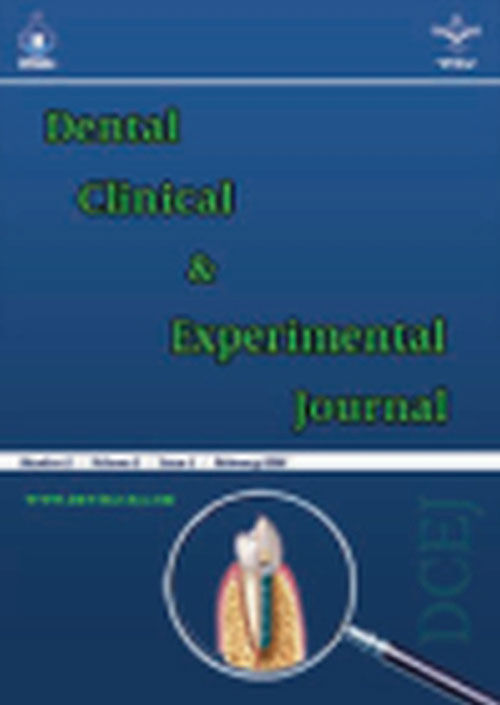فهرست مطالب

Dental Clinical and Experimental Journal
Volume:4 Issue: 1, Dec 2018
- تاریخ انتشار: 1398/05/01
- تعداد عناوین: 5
-
Page 1BackgroundOral cancer is one of the highly prevalent cancers in the world.ObjectivesSince the role of Candida in premalignant and malignant lesions of the oral cavity is not fully understood, the purpose of this study was to determine the prevalence of Candida and its association with the potentially malignant and malignant lesions of the oral cavity.MethodsIn this descriptive-analytical study, 60 malignant and premalignant lesions (35 cases of squamous cell carcinoma, 16 cases of oral lichen planus, and 9 cases of leukoplakia) were obtained from the Pathology Department of Zahedan Dental School. Two tissue sections (5 µm) of each sample were stained with Hematoxylin and Eosin (H & E) and periodic acid-Schiff’s (PAS) reagent to evaluate for fungal hyphae under a light microscope. The collected data were analyzed using SPSS (V.21) by Fisher’s exact test.ResultsFrom the 35 cases with oral squamous cell carcinoma, 16 (45.7%) were positive for Candida hyphae. Among the potentially malignant lesions, 4 (25%) cases with oral lichen planus and 2 (22.2%) cases with leukoplakia demonstrated the presence of Candida hyphae. No statistically significant difference was found in the presence of Candida between potentially malignant and malignant lesions (P = 0.073).ConclusionsThe study showed that the prevalence of Candida was higher in malignant lesions than in premalignant lesions, but this difference was not statistically significant. Therefore, Candida cannot be a useful indicator in predicting malignancy development.Keywords: Candida, Malignant, Potentially Malignant, Oral Lesions
-
Cytological Evaluation of Cellular Atypia in the Oral Mucosa of Active and Passive Cigarette SmokersPage 2BackgroundThe cigarette is the most known and important risk factor for squamous cell carcinoma of the mouth and pharynx.ObjectivesThis study aimed to compare the cellular atypia in the oral mucosa of active and passive smokers by brush cytology.MethodsThis case-control study included 40 active smokers, 40 passive smokers, and 40 non-smokers. The floor of the mouth and the tongue border of the participants were dried with a sterile gauze and sampling was done with moderate pressure by brush. The findings entered the SPSS software version 21 and Kruskal-Wallis test for statistical analysis was used.ResultsAverage atypia percent in non-smokers, active smokers, and passive smokers was 48.56, 79.21, 53.73, respectively that shows the average percent of cellular atypia is not equal among smoking groups and this difference is significant (P = 0.000).ConclusionsThe results of this study showed that cellular atypia in active smokers has a significant difference compared to passive smokers and non-smoker subjects.Keywords: Oral Mucosa, Cytology, Passive Smoking
-
Antimicrobial Activity of Platelet-Rich Plasma and Platelet-Rich Fibrin Against Streptococcos OralisPage 3BackgroundIn recent years, the regenerative potential of platelet-rich plasma (PRP) and platelet-rich fibrin (PRF) have been studied in various fields of medicine.ObjectivesThe purpose of this study was to investigate the antimicrobial activity of PRP and PRF against Streptococcus Oralis.MethodsIn this in vitro study, minimum inhibitory concentration (MIC) and minimum bactericidal concentration (MBC) against this organism were determined by microdilution broth in visual method and turbidity by ELISA reader. The assay was done in triplicate. The results were analyzed using analysis of variance (ANOVA) test.ResultsComparison of MIC at various concentrations of the solution showed that there was a significant difference between MIC of PRP and PRF. Moreover, the results showed that PRP and PRF solutions have not led to a complete halt in bacterial growth (MBC).ConclusionsPRF in comparison to PRP results increased the inhibition of bacterial growth and is recommended for use in the treatment of most studies.Keywords: Antibacterial, Periodontitis, PRP, PRF
-
Page 4BackgroundInformation about the oral hygiene of pregnant women and related factors is necessary for the oral health promotion programs. To our knowledge, there were no data regarding the oral hygiene of pregnant women in Zahedan.ObjectivesThe present study was aimed to evaluate the oral hygiene status in a sample of pregnant Iranian women (in Zahedan) by measuring the OHI-S and its relationship with demographic variables.MethodsIn this cross sectional analytical study, coordination with health centers in Zahedan was done and then 150 pregnant women examined after completing an informed consent form. Characteristics of pregnant women were recorded in the demographic part of the form, to evaluate the oral hygiene status of pregnant women, OHI-S was measured. Descriptive statistics and chi-square test (SPSS V. 22 software) were used to evaluate the oral hygiene of pregnant women and its relationship with demographic characteristics.ResultsThe results showed that the oral hygiene index (OHI-S) of 36.7% pregnant women was poor, 42% moderate and 21.3% was at a good level. The index was statistically related to some socio-demographic characteristics of pregnant women such as education, parity (number of children) and occupation (P < 0.05). There was not a significant relationship between OHI-S and the age of mothers.ConclusionsThe results of the present study showed that despite pregnant women being referred to the health centers of Zahedan and registered for health visits, OHI-S of most women was not good. Also, the study revealed a relationship between demographic factors such as occupation, education, parity and oral hygiene. In addition, the study revealed an association between demographic factors such as occupation, education, parity and oral hygiene.Keywords: Pregnancy, Oral, Dental Health, Oral Hygiene Index Simplified

